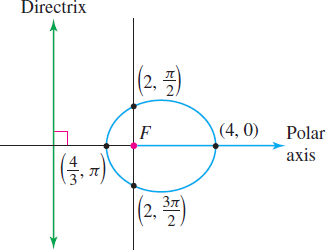EXAMPLE 1Identifying and Graphing the Polar Equation of a Conic
(a) Identify and graph the equation r=42−cosθ.
(b) Convert the polar equation to a rectangular equation.
(c) Find parametric equations for the polar equation.
Solution (a) We divide the numerator and the denominator by 2 to express the equation in the form r=ep1−ecosθ. r=42−cosθ=21−12cosθr=ep1−ecosθ
Now we see that e=12. Since ep=2, we find p=2e=212=4. This is an ellipse, because e=12<1. One focus is at the pole, and the directrix is perpendicular to the polar axis a distance of p=4 units to the left of the pole. The major axis is along the polar axis.
Letting θ=0 and θ=π, we can find the vertices of the ellipse. r=42−cos0=42−1=4andr=42−cosπ=42−(−1)=43
687
So, the vertices of the ellipse are the points whose polar coordinates are (4,0) and (43,π). The y-intercepts of the ellipse are at θ=π2 and θ=3π2, which give rise to the points (2,π2) and (2,3π2). The graph of the ellipse is shown in Figure 60.
(b) To obtain a rectangular equation of the ellipse, we eliminate the fraction and then square the resulting polar equation. r=42−cosθr(2−cosθ)=42r−rcosθ=42r=4+rcosθ4r2=(4+rcosθ)2Square the equation.4(x2+y2)=(4+x)2r2=x2+y2,x=rcosθ4x2+4y2=16+8x+x23(x2−83x)+4y2=163(x−43)2+4y2=16+3(169)=643Complete the square in x.
This is the equation of an ellipse in rectangular coordinates, with its center at the point (43,0) in rectangular coordinates.
(c) Parametric equations of the ellipse r=42−cosθ are x(θ)=rcosθ=4cosθ2−cosθy(θ)=rsinθ=4sinθ2−cosθ0≤θ≤2π where θ is the parameter.
